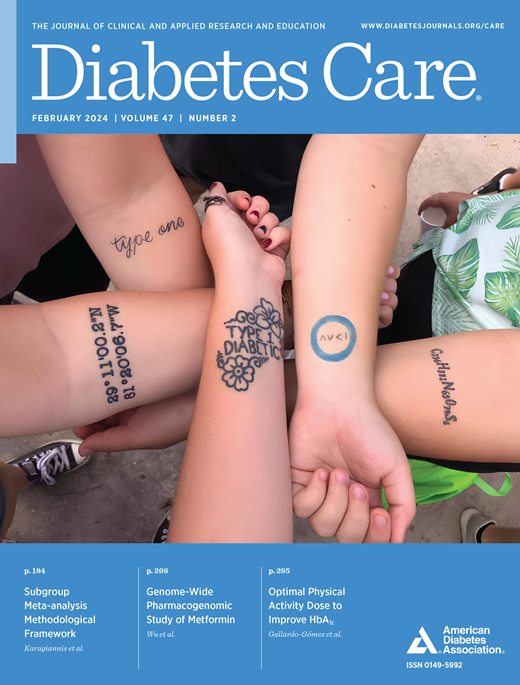Visit-to-Visit Variability in Lipid Levels and Risk of Incident Heart Failure in Adults With Type 2 Diabetes
IF 16.6
1区 医学
Q1 ENDOCRINOLOGY & METABOLISM
引用次数: 0
Abstract
OBJECTIVE Limited data exist on the relation between long-term variability in blood lipid fractions and incident heart failure (HF) in the setting of type 2 diabetes mellitus (T2DM). RESEARCH DESIGN AND METHODS Among 9,443 T2DM participants from the Action to Control Cardiovascular Risk in Diabetes (ACCORD) study, with lipid measurements available at six time points (baseline, 4, 8, 12, 24, and 36 months), we assessed variability in total cholesterol (TC), LDL cholesterol, HDL cholesterol, and triglycerides (TG) across visits, using coefficient of variation (CV), SD, and variability independent of the mean. Cox proportional hazards models were employed to estimate adjusted hazard ratios (HRs) for incident HF. RESULTS During a median follow-up of 5.0 years, 345 participants developed HF. Participants in the highest quartile of CV of TC had a 68% higher relative risk of HF compared with those in the lowest quartile (adjusted HR [aHR] 1.68, 95% CI 1.22–2.30). Similarly, those in the highest quartile of LDL cholesterol CV had a 76% higher relative risk (aHR 1.76, 95% CI 1.27–2.42) of HF, while those in the highest quartile of HDL cholesterol CV had a 53% higher risk (aHR 1.53, 95% CI 1.13–2.06). For TG CV, participants in the highest quartile had a 49% higher risk of HF compared with the lowest quartile (aHR 1.49, 95% CI 1.09–2.04). Similar patterns were observed for other variability metrics. CONCLUSIONS Increased variability in TC, LDL- cholesterol, HDL- cholesterol, or TG is independently associated with a higher HF risk among individuals with T2DM.成人2型糖尿病患者血脂水平和心力衰竭风险的访间变异性
目的:关于2型糖尿病(T2DM)患者血脂长期变异性与心力衰竭(HF)之间关系的研究数据有限。研究设计和方法在9443名T2DM参与者中,通过六个时间点(基线、4、8、12、24和36个月)的脂质测量,我们评估了总胆固醇(TC)、低密度脂蛋白胆固醇、高密度脂蛋白胆固醇和甘油三酯(TG)的变异性,使用变异系数(CV)、SD和独立于平均值的变异性。采用Cox比例风险模型估计心衰事件的调整风险比(hr)。结果:在中位随访5.0年期间,345名参与者发生心衰。TC CV最高四分位数的参与者发生HF的相对风险比最低四分位数的参与者高68%(校正HR [aHR] 1.68, 95% CI 1.22-2.30)。同样,LDL胆固醇CV最高四分位数的患者发生HF的相对风险高出76% (aHR 1.76, 95% CI 1.27-2.42),而HDL胆固醇CV最高四分位数的患者发生HF的相对风险高出53% (aHR 1.53, 95% CI 1.13-2.06)。对于TG CV,最高四分位数的参与者发生HF的风险比最低四分位数的参与者高49% (aHR 1.49, 95% CI 1.09-2.04)。在其他可变性指标中也观察到类似的模式。结论:T2DM患者中TC、LDL-胆固醇、HDL-胆固醇或TG变异性的增加与较高的HF风险独立相关。
本文章由计算机程序翻译,如有差异,请以英文原文为准。
求助全文
约1分钟内获得全文
求助全文
来源期刊

Diabetes Care
医学-内分泌学与代谢
CiteScore
27.80
自引率
4.90%
发文量
449
审稿时长
1 months
期刊介绍:
The journal's overarching mission can be captured by the simple word "Care," reflecting its commitment to enhancing patient well-being. Diabetes Care aims to support better patient care by addressing the comprehensive needs of healthcare professionals dedicated to managing diabetes.
Diabetes Care serves as a valuable resource for healthcare practitioners, aiming to advance knowledge, foster research, and improve diabetes management. The journal publishes original research across various categories, including Clinical Care, Education, Nutrition, Psychosocial Research, Epidemiology, Health Services Research, Emerging Treatments and Technologies, Pathophysiology, Complications, and Cardiovascular and Metabolic Risk. Additionally, Diabetes Care features ADA statements, consensus reports, review articles, letters to the editor, and health/medical news, appealing to a diverse audience of physicians, researchers, psychologists, educators, and other healthcare professionals.
 求助内容:
求助内容: 应助结果提醒方式:
应助结果提醒方式:


